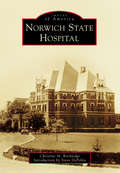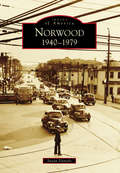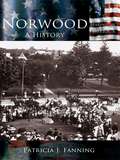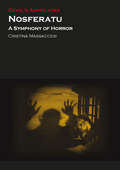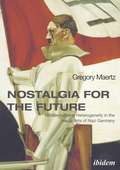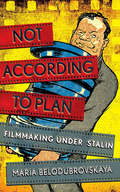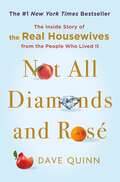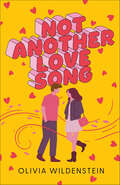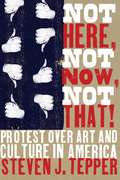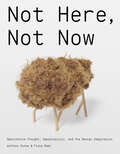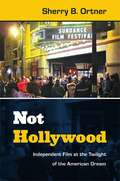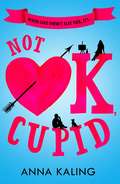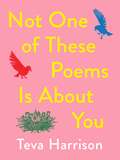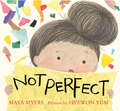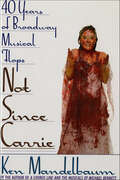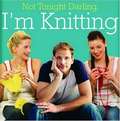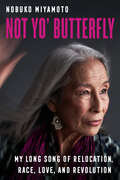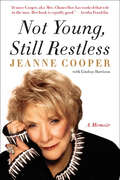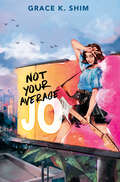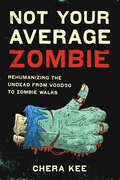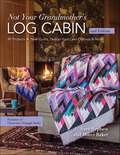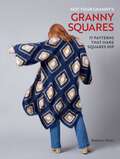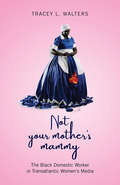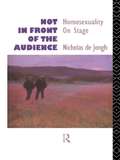- Table View
- List View
Norwood: 1940-1979 (Images of America)
by Susan DanielsAlthough settlers moved into Norwood as early as 1787, Norwood was not incorporated as a city until 1902. Apart from the city of Cincinnati, Norwood is the second largest city within Hamilton County, Ohio. Several large companies, such as Globe Wernicke Company and the United States Playing Card Company, were developed in Norwood, creating rapid industrial growth and many job opportunities through the years. With the large companies booming came the development of homes, schools, and small businesses. Norwood: 1940–1979 depicts how citizens lived, shopped, worked, and played during Norwood’s heyday.
Norwood: A History (Making of America)
by Patricia J. FanningBefore Norwood, Massachusetts became a town in 1872, hardy settlers from Dedham left security and comfort behind and began building homes along the Neponset River and Hawes Brook. Living in an area still known as the South Parish, these hard-working citizens fought for their values in both the Revolutionary and Civil Wars. The town encouraged industry and diversity, expanding its primarily agricultural base until the community could boast a stable, if ever changing, economy. Wealthy industrialists and working-class immigrants united to build this New England town and to foster its growth into the Norwood of today: a vital community that residents are proud to call home.Norwood: A History recounts stories of the visionaries produced here, such as Captain Aaron Guild, who "left plough in furrow and oxen standing" to join the April 19, 1775, battle at Lexington. The formation and success of the Civic Association and the hospital were due to the perseverance of the public-spirited population, guided by the charismatic and driven George Willett. Readers will discover how athletics helped put Norwood on the map, from the polo fields of W. Cameron Forbes to the reign of Roll-Land as one of the country's premiere roller-skating arenas. As tales of years gone by give way to progress, Norwood: A History also looks ahead to new enterprises, which have followed in the footsteps of companies such as Winslow Brothers and Smith and the Norwood Press.
Nosferatu: A Symphony of Horror (Devil's Advocates)
by Cristina MassaccesiNosferatu: A Symphony of Horror, directed by German director Friedrich Wilhelm Murnau in 1922, is not only regarded as one of the most intriguing and disquieting films to have been produced during the years of Weimar cinema but is also a key step in establishing the vampire as a cinematic figure and in shaping its connection with our subconscious fears and desires. In her analysis of this hugely influential film, Cristina Massaccesi unravels the never-ending fascination exercised by the film over generations of viewers and filmmakers whilst at the same time providing the reader with a clear guide about the film's contexts, cinematography, and possible interpretations, covering the political and social context of the Weimar Republic and its film industry, the German Expressionist movement, the film's production, reception and difficult initial release. The book also includes the results of a lengthy interview between the author and E. Elias Merhige, director of the Nosferatu homage, Shadow of the Vampire (2000).
Nostalgia for the Future: Modernism and Heterogeneity in the Visual Arts of Nazi Germany
by Gregory MaertzFrom the early years of the Weimar Republic until the collapse of Hitler’s regime, demonizing modernist art as a symptom of the corruption of German culture was a standard trope in National Socialist propaganda. But how consistent and thorough was Nazi censorship of modernist artists? Maertz’s pioneering research unearths the persistence of recognizable modernist styles in painting and sculpture produced under the patronage of the Nazi Party and German government institutions, even after the infamous 1937 purge of “degenerate art” from state-funded museums.In the first chapter on Hitler’s advocacy for “eugenic” figurative representation embodying Nazi nostalgia for lost Aryan racial perfection and the aspiration for the future perfection of the German Volk, and in the second chapter on the appropriation of Christian iconography in constructing symbols of a Nazi racial utopia, Maertz conclusively proves that the Nazi attack on modernism was inconsistent. In further chapters, demonstrating Baldur von Schirach’s heretical patronage of modernist art as the supreme Nazi Party authority in Vienna and the German military’s unlikely function as an incubator of modernist art, Maertz reveals that the sponsorship of modernist artists continued until the collapse of the regime. Also based on previously unexamined evidence, including 10,000 works of art confiscated by the U.S. Army, Maertz’s final chapter reconstructs the anarchic denazification and rehabilitation of German artists during the Allied occupation, which had unforeseen consequences for the postwar art world.
Not According to Plan: Filmmaking under Stalin
by Maria BelodubrovskayaIn Not According to Plan, Maria Belodubrovskaya reveals the limits on the power of even the most repressive totalitarian regimes to create and control propaganda. Belodubrovskaya's revisionist account of Soviet filmmaking between 1930 and 1953 highlights the extent to which the Soviet film industry remained stubbornly artisanal in its methods, especially in contrast to the more industrial approach of the Hollywood studio system. Not According to Plan shows that even though Josef Stalin recognized cinema as a "mighty instrument of mass agitation and propaganda" and strove to harness the Soviet film industry to serve the state, directors such as Eisenstein, Alexandrov, and Pudovkin had far more creative control than did party-appointed executives and censors.
Not All Diamonds and Rosé: The Inside Story of The Real Housewives from the People Who Lived It
by Dave QuinnTHE INSTANT #1 NEW YORK TIMES BESTSELLER! <p><p> Dave Quinn's Not All Diamonds and Rosé is the definitive oral history of the hit television franchise, from its unlikely start in the gated communities of Orange County to the pop culture behemoth it has become—spanning nine cities, hundreds of cast members, and millions of fans. <p><p> What is it really like to be a housewife? We all want to know, but only the women we love to watch and the people who make the show have the whole story. Well, listen in close, because they’re about to tell all. <p><p> Nearly all the wives, producers, and network executives, as well as Andy Cohen himself, are on the record, unfiltered and unvarnished about what it really takes to have a tagline. This is your VIP pass to the lives behind the glam squads, testimonials, and tabloid feuds. <p><p> Life’s not all diamonds and rosé, but the truth is so much better, isn’t it?
Not Another Love Song
by Olivia WildensteinPerfect for fans of Lynn Painter and K. L. Walther, this timeless, compelling YA romance centers on a teen desperate to make it in the music industry - but at what cost? I really wish you could make it easier for me to dislike you.Angie Conrad has always known she wanted to be a musician, growing up in Nashville it’s all she’s ever dreamed of. Now a high school senior, she has the opportunity to kick-start her dreams via a songwriting competition for her idol, Mona Stone. Driven to succeed, she begins working on the perfect song to submit, but there are more than just a few obstacles in her way—her crippling stage fright and her mother’s disapproval to name a few. When Angie meets Reedwood High’s newest transfer student, Ten Dylan, things get complicated. With his endless collection of graphic tees, his surly attitude, and smoldering good looks, Ten toys with the rhythm of Angie’s heart. There’s just one mind boggling problem: he absolutely hates music, especially Mona Stone.She’s never desired anything but success until Ten entered her life. Now she wants to be with him and to be a songwriter for Mona Stone.But picking one means losing the other.Charming and full of heart, Not Another Love Song is perfect for readers looking for: - Contemporary YA romance - Enemies-to-lovers - Dating You Would Ruin Everything (But They Do It Anyway) - Music-filled stories about aspiring singer-songwriters (total Swiftie vibes!) - Lynn Painter Fans - K. L. Walther fans
Not Here, Not Now, Not That!: Protest over Art and Culture in America
by Steven J. TepperIn the late 1990s Angels in America,Tony Kushner’s epic play about homosexuality and AIDS in the Reagan era, toured the country, inspiring protests in a handful of cities while others received it warmly. Why do people fight over some works of art but not others? Not Here, Not Now, Not That! examines a wide range of controversies over films, books, paintings, sculptures, clothing, music, and television in dozens of cities across the country to find out what turns personal offense into public protest. What Steven J. Tepper discovers is that these protests are always deeply rooted in local concerns. Furthermore, they are essential to the process of working out our differences in a civil society. To explore the local nature of public protests in detail, Tepper analyzes cases in seventy-one cities, including an in-depth look at Atlanta in the late 1990s, finding that debates there over memorials, public artworks, books, and parades served as a way for Atlantans to develop a vision of the future at a time of rapid growth and change. Eschewing simplistic narratives that reduce public protests to political maneuvering, Not Here, Not Now, Not That! at last provides the social context necessary to fully understand this fascinating phenomenon.
Not Here, Not Now: Speculative Thought, Impossibility, and the Design Imagination
by Anthony Dunne Fiona RabyWhat it means to design at a time when, for many people, the future seems to have become an impossibility.When reality fails us, what can designers do? Question design&’s relationship to reality, as Anthony Dunne and Fiona Raby do, in this exhilarating, yet thoughtful, journey to the edges of science, philosophy, and literature to find new ways of thinking about the possible—and about the meaning, function, and place of design in that speculative world of &“not here, not now.&” A conceptual travelogue of sorts, Not Here, Not Now brings together words, images, and objects that capture, in design form, some of the ideas encountered along the way. Itself a design experiment, the richly illustrated book explores ways to bring these ideas into conversation with objects through imagined archives, libraries, glossaries, taxonomies, lists, tales, and essays.The design responses in Not Here, Not Now—to a stone raft, for example, or a vegetable lamb, swatches of imaginary colors, a pocket universe in the home, objects undergoing space-time collapse—are, like the most compelling utopias, impossible by design, aiming instead to nourish the creative, intellectual, and imaginative ground from which new possibilities, still unknown, might begin to emerge.
Not Hollywood: Independent Film at the Twilight of the American Dream
by Ortner Sherry B.The pioneering anthropologist Sherry B. Ortner combines her trademark ethnographic expertise with critical film interpretation to explore the independent film scene in New York and Los Angeles since the late 1980s. Not Hollywood is both a study of the lived experience of that scene and a critical examination of America as seen through the lenses of independent filmmakers. Based on interviews with scores of directors and producers, Ortner reveals the culture and practices of indie filmmaking, including the conviction of those involved that their films, unlike Hollywood movies, are "telling the truth" about American life. These films often illuminate the dark side of American society through narratives about the family, the economy, and politics in today's neoliberal era. Offering insightful interpretations of many of these films, Ortner argues that during the past three decades independent American cinema has functioned as a vital form of cultural critique.
Not OK, Cupid: A sparkling rom-com you won't want to put down!
by Anna KalingAnna Kaling's sparkling debut rom-com, Not OK, Cupid, is perfect for fans of Sophie Ranald, Jo Watson and Sally Thorne. Readers are raving about Not OK, Cupid!'I'm pretty sure I have NEVER laughed so hard in my entire life...a rom-com fan's dream' 5* reader review'Great characters, lots of laughs, and oh-so-hot sex scenes' 5* reader review'Positively the best romantic comedy I've read in a long time' 5* reader reviewLove doesn't always follow the rules...Ally Rivers has three jobs, a disastrous dating record, and her gran won't stop talking about sex with eighty-year-old Melvin. Now her best friend Sam confesses his whole family think they're engaged. The longest relationship she's ever been in is fabricated, and her intended is gay. Playing Sam's besotted lover at a family party, Ally discovers the hot gardener she's been flirting with is Sam's dad, Marcus. She even sucks at fake relationships. But Marcus is on to them and embroils Ally in another scheme - encouraging Sam to come out. Scheming is not Ally's forte and, worse, she and Marcus are falling for each other. After years in an unhappy marriage, he's not letting Ally go without a fight, but she's torn between the best friend she'll ever have and the only man she's ever been in love with. Either choice will leave two broken hearts, and Gran will still have a more successful love life than her...
Not OK, Cupid: A sparkling rom-com you won't want to put down!
by Anna KalingAnna Kaling's sparkling debut rom-com, Not OK, Cupid, is perfect for fans of Sophie Ranald, Jo Watson and Sally Thorne. Readers are raving about Not OK, Cupid!'I'm pretty sure I have NEVER laughed so hard in my entire life...a rom-com fan's dream' 5* reader review'Great characters, lots of laughs, and oh-so-hot sex scenes' 5* reader review'Positively the best romantic comedy I've read in a long time' 5* reader reviewLove doesn't always follow the rules...Ally Rivers has three jobs, a disastrous dating record, and her gran won't stop talking about sex with eighty-year-old Melvin. Now her best friend Sam confesses his whole family think they're engaged. The longest relationship she's ever been in is fabricated, and her intended is gay. Playing Sam's besotted lover at a family party, Ally discovers the hot gardener she's been flirting with is Sam's dad, Marcus. She even sucks at fake relationships. But Marcus is on to them and embroils Ally in another scheme - encouraging Sam to come out. Scheming is not Ally's forte and, worse, she and Marcus are falling for each other. After years in an unhappy marriage, he's not letting Ally go without a fight, but she's torn between the best friend she'll ever have and the only man she's ever been in love with. Either choice will leave two broken hearts, and Gran will still have a more successful love life than her...
Not One of These Poems Is About You
by Teva HarrisonFrom Teva Harrison, the award-winning author and illustrator of In-Between Days, comes a powerful work of poetry and art in which she continues to explore what it means to live with metastatic breast cancer.In this remarkable, frank, and gut-wrenching mix of words and images, Teva continues on her journey, grappling with what it means to live with metastatic breast cancer. She plunges deep into her inner world, shadowing the progression of the disease. Reality takes on sharp edges: the swell of cancer and its retreat with chemo. Her inner corporeal reality versus her outer manifestation of health, vitality, and femininity. Holding fast to the great love of her life, while preparing to leave him behind. Contemplating who she was before cancer, and who she is now.Starkly honest and wholly profound, Not One of These Poems Is About You distills life to its essence. Teva Harrison continues to gift the world with her clear-eyed insight and her open heart.
Not Perfect
by Maya MyersFrom the creators of Not Little, the intrepid Dot is back with an endearing story about embracing the mistakes that let us build new skills.Dot is good at a lot of things, but good isn&’t perfect. Perfect is her sister&’s blue-ribbon painting, or her brothers&’ first-place tie in the spelling bee, or her mom&’s black belt in tae kwon do. Dot tries and tries, but all she has to show for it is funny-looking cupcakes, off-key piano squeaks, and almost-goals in soccer. Nothing she does is perfect.When Dot and her classmates get an assignment to make a poster about a person they admire, Dot has someone in mind right away: her best friend, Sam. But draft after draft comes out looking all wrong! How will she ever make the perfect poster for her perfect friend?Fans of Dot and Sam and new readers alike will melt as Dot keeps on trying in this relatable companion to Not Little, featuring Maya Myers&’s effortless narrative voice and Hyewon Yum&’s irresistible illustrations.A Junior Library Guild Gold Standard Selection
Not Since Carrie: 40 Years of Broadway Musical Flops
by Ken MandelbaumNot Since Carrie is Ken Mandelbaum's brilliant survey of Broadway's biggest flops. This highly readable and entertaining book highlights almost 200 musicals created between 1950 and 1990, framed around the notorious musical adaptation of Carrie, and examines the reasons for their failure. "Essential and hilarious," raves The New Yorker, and The New York Times calls the book "A must-read."
Not Tonight Darling, I'm Knitting
by Betsy HosegoodWhat could be more alluring than the silky feel of yarn between your fingers, the rhythmic click of needles in your hands, and the satisfaction of watching your beloved ball of bouclé transform into a sensational creation? Well, there's always the joy of: * getting social and knitting with friends * meeting like-minded knit-chicks * celeb spotting the knitterati * shopping for the latest on-trend yarns * surfing the knit-blogs for gossip * casting on and chilling out So put down your needles, wind up your yarn, and indulge in this vivacious celebration of your passion for knitting!
Not Yo' Butterfly: My Long Song of Relocation, Race, Love, and Revolution (American Crossroads #60)
by Nobuko MiyamotoA mold-breaking memoir of Asian American identity, political activism, community, and purpose.Not Yo’ Butterfly is the intimate and unflinching life story of Nobuko Miyamoto—artist, activist, and mother. Beginning with the harrowing early years of her life as a Japanese American child navigating a fearful west coast during World War II, Miyamoto leads readers into the landscapes that defined the experiences of twentieth-century America and also foregrounds the struggles of people of color who reclaimed their histories, identities, and power through activism and art. Miyamoto vividly describes her early life in the racialized atmosphere of Hollywood musicals and then her turn toward activism as an Asian American troubadour with the release of A Grain of Sand—considered to be the first Asian American folk album. Her narrative intersects with the stories of Yuri Kochiyama and Grace Lee Boggs, influential in both Asian and Black liberation movements. She tells how her experience of motherhood with an Afro-Asian son, as well as a marriage that intertwined Black and Japanese families and communities, placed her at the nexus of the 1992 Rodney King riots—and how she used art to create interracial solidarity and conciliation. Through it all, Miyamoto has embraced her identity as an Asian American woman to create an antiracist body of work and a blueprint for empathy and praxis through community art. Her sometimes barbed, often provocative, and always steadfast story is now told.
Not Young, Still Restless: A Memoir
by Lindsay Harrison Jeanne CooperThe New York Times–bestselling memoir from one of daytime television’s most beloved actresses.Jeanne Cooper, the Emmy Award–winning American actress best known for her portrayal of Katherine Chancellor on the daytime soap opera The Young and the Restless, recounts the steps and missteps of her six-decade career in Not Young, Still Restless. Exploring a career that began with the birth of a phenomenon called television, Cooper’s life story co-stars a cast of characters that reads like a who’s-who of Hollywood’s Golden Age: Frank Sinatra, Tony Curtis, Henry Fonda, and Shelley Winters, to name just a few. Intimate, honest, and inspiring, Not Young, Still Restless is a fascinating memoir of a life in daytime drama—and proof positive that that growing older doesn’t have to mean giving up.
Not Your Average Jo
by Grace K. ShimFrom the author of THE NOH FAMILY, a second standalone YA novel that follows a Korean American teen as she navigates the treacherous world of nepo babies and cultural appropriation that is the Los Angeles music scene. Perfect for fans of Mary H. K. Choi, Maurene Goo, and Emiko Jean.Riley Jo is a teenager who knows what she wants. Born and raised in Bentonville, Arkansas, this Korean American girl has her sights set on being a musician. So when her parents are surprisingly cool about her attending the prestigious Los Angeles–based arts-focused boarding school her senior year of high school, she jumps at the chance. This is her moment to make her indie rock dreams a reality! Things at Carlmont Academy start out strong: She joins a band, and they set out to make plans to perform at the annual spring concert—with a chance to land a record contract. Another student, Xander, decides his school project will be a documentary about the band leading up to their first show. But not everything goes how Riley Jo imagined. She is soon sidelined when her other bandmates feel she is "too Asian" to be their lead singer, and they choose her classmate Bodhi Collins for the role instead.Bodhi is rock music royalty, with a dad who is a famous music exec. And he's got the "all-American rock star look." Her classmates suggest she try making K-pop, but her heart is in indie rock. Riley Jo decides to take matters into her own hands and writes an original song to showcase her talent. But Bodhi takes the credit . . . and given his connections, the band lets him.Xander captures all of this in his film, which he leaks in order to show the truth behind the band. Riley Jo decides to sign up for the spring concert and perform on her own . . . but will she finally be able to take center stage?
Not Your Average Zombie: Rehumanizing the Undead from Voodoo to Zombie Walks
by Chera KeeThe zombie apocalypse hasn’t happened—yet—but zombies are all over popular culture. From movies and TV shows to video games and zombie walks, the undead stalk through our collective fantasies. What is it about zombies that exerts such a powerful fascination? In Not Your Average Zombie, Chera Kee offers an innovative answer by looking at zombies that don’t conform to the stereotypes of mindless slaves or flesh-eating cannibals. Zombies who think, who speak, and who feel love can be sympathetic and even politically powerful, she asserts. Kee analyzes zombies in popular culture from 1930s depictions of zombies in voodoo rituals to contemporary film and television, comic books, video games, and fan practices such as zombie walks. She discusses how the zombie has embodied our fears of losing the self through slavery and cannibalism and shows how “extra-ordinary” zombies defy that loss of free will by refusing to be dehumanized. By challenging their masters, falling in love, and leading rebellions, “extra-ordinary” zombies become figures of liberation and resistance. Kee also thoroughly investigates how representations of racial and gendered identities in zombie texts offer opportunities for living people to gain agency over their lives. Not Your Average Zombie thus deepens and broadens our understanding of how media producers and consumers take up and use these undead figures to make political interventions in the world of the living.
Not Your Grandmother's Log Cabin
by Marci Baker Sara NephewShake up your Log Cabin with a 60° ruler! Best-selling authors Marci Baker and Sara Nephew are back with a new slant on the classic Log Cabin. This updated second edition includes 6 amazing new patterns, for a total of 40 projects! Use the 10" Clearview Triangle ruler, also sold by C&T Publishing for fast and easy cutting. A robust "design your own" section with setting shapes, alternate blocks, and border options will help you uncover infinite possibilities. This fully illustrated guide includes easy-to-use troubleshooting tips and detailed material lists for all the quilts. • 40 projects from best-selling authors Marci Baker and Sara Nephew • For fast and easy cutting use 10" Clearview Triangle ruler, also sold by C&T Pubishing • "You can design it" section with tips to inspire your own creations
Not Your Granny's Granny Squares
by Babette UlmerThere was a time when granny squares were reserved for afghans and armchair covers. Not anymore! Fashion designer and crochet master Babette Ulmer shows you how to make nostalgic crochet squares and turn them into fun, fashion-forward, contemporary pieces of wearable art.Granny squares have been around for more than 125 years and for a long time, they were just for making blankets. But now they can be seen everywhere, from social media to the pages of Vogue. Far from being old-fashioned, these works of crocheted art are the fashion world&’s hottest trend. And now, with Not Your Granny&’s Granny Squares you can make some of the coolest granny square clothes you&’ll ever see. Crochet master and fashion designer Babette Ulmer has created patterns for everything from headbands, scarves, and tote bags to gorgeous halter tops, skirts, cardigans, dusters, and more. With detailed instructions on how to make all kinds of squares, easy-to-follow patterns, and even a bit of history about the granny square itself, this is the only book you&’ll need to crochet your own iconic granny square look. STEP BY STEP INSTRUCTIONS: Includes easy-to-read instructions, charts, and schematics that make knitting these patterns fun and easy. STUNNING IMAGES: Enjoy beautiful full-color photography and iconic images of models wearing their granny squares on the runway. AN INSIDE LOOK at the fashion industry through the perspective of professional designer/ granny square knitter, Babette Ulmer. FOR FANS OF CRAFTING AND FASHION: Not Your Granny&’s Granny Squares features easy-to-read instructions and informative essays about the craft&’s history.
Not Your Mother's Mammy: The Black Domestic Worker in Transatlantic Women’s Media
by Tracey L WaltersNot Your Mother’s Mammy examines how black artists of the African diaspora, many of them former domestics, reconstruct the black female subjectivities of domestics in fiction, film, and visual and performance art. In doing so, they undermine one-dimensional images of black domestics as victims lacking voice and agency and prove domestic workers are more than the aprons they wear. An analysis of selected media by Alice Childress, Nandi Keyi, Victoria Brown, Kara Walker, Mikalene Thomas, Rene Cox, Lynn Nottage, and others provides examples of generations of domestics who challenged their performative roles of subservience by engaging in subversive actions contradicting the image of the deferential black maid. Through verbal confrontation, mobilization, passive resistance, and performance, black domestics find their voices, exercise their power, and maintain their dignity in the face of humiliation. Not Your Mother’s Mammy brings to life stories of domestics often neglected in academic studies, such as the complexity of interracial homoerotic relationships between workers and employers, or the mental health challenges of domestics that lead to depression and suicide. In line with international movements like #MeToo and #timesup, the women in these stories demand to be heard.
Not in Front of the Audience: Homosexuality On Stage
by Nicholas de JonghFirst published in 1992. Routledge is an imprint of Taylor & Francis, an informa company.
